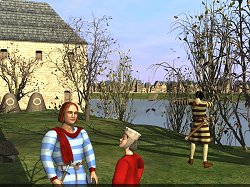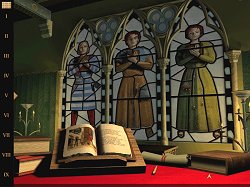|
Paris 1313: The Mystery of Notre Dame
 Another historical edutainment presentation from the makers of Vikings and Crusader, this is a nice little set of puzzles draped about the shoulders of an intriguing tale concerning the making of the first mechanical clock. It all takes place in 14th century Paris, and isn't half bad. Another historical edutainment presentation from the makers of Vikings and Crusader, this is a nice little set of puzzles draped about the shoulders of an intriguing tale concerning the making of the first mechanical clock. It all takes place in 14th century Paris, and isn't half bad.
The story has 9 chapters, and you get to play almost each one as three separate characters. Each chapter begins by reading a short extract from the storybook which is compiled as you go. This sets the scene. You then choose one of the three main characters - Jacques, Rosamonde or Pierre - by clicking their stained glass image. Moving your curser over each will bring up a short commentary on what lies before that character in that chapter. Once you choose, a scene will play out, culminating in a puzzle which you must solve.
You might have to untie the ropes binding Rosamonde, mend a broken mechanical bird, work out the heraldry on a shield, win a game of dice, or reassemble the expressions of love on 8 dress-clasps. The majority are intuitive, a couple less so. All of them fit well into the period and the plot. Some are new - my favourite was trying to maneavour Jacques up a wall to do a bit of eavesdropping. You had to move his hands and feet one by one, finding purchase on the holes and stones where you could, being careful not to over-reach, or over-tax Jacques who was puffing with the exertion.
You may or may not successfully complete the puzzle, with varying consequences for your character. You can abandon the puzzle and try a different character. To be able to move on to the next chapter, you must successfully complete two of the three puzzles. Later in the game, all three must be completed.
However, apart from wanting to do all the puzzles, only doing two puzzles will mean you miss a part of the unfolding story. This is a single tale in which the 3 main characters take part, concerning the death of the maker of the clock. Needless to say, given the time period the church in all its guises is prominent, as is the court of King Philippe. Love and intrigue abound as you try to resolve the circumstances of the death and do your best to avoid being duped or treacherously framed.
At times a chapter will have all three main characters participating in essentially the same scene, but observed from their different perspectives. At other times each is busy doing his or her own thing. All of them though are participating in sorting out the intricacies of the plot. Not playing one of the characters in each chapter is not quite the same as not reading every third page of a book, but you will miss stuff.
 I did notice that within some chapters the storyline could be a bit disjointed, depending upon the order in which you played the characters. But it tended to come together once you had played each one.
The fact that each of the main characters comes from a different social strata adds to the story and how it develops. The nephew of a high ranking politician can move about the castle and interact with royalty, whereas the street performer will more likely frequent the taverns and markets.
In the scenes preceding the puzzles, there are some interactions and some dialogue trees to engage you. In many, it matters not what you do or say. In others, the scene will end in failure if you answer incorrectly, or perform the wrong action.
Like all such products, there is a detailed encyclopedia you can consult at will, and as you move around Paris cursors will indicate a hotlink to the encyclopedia to provide more information about whatever it is you are looking at. Unlike some such games, you don't need to spend much time at all in the encyclopedia if you don't want to. I consulted it once to get some information on heraldry, but other than that I left it alone whilst playing.
I did have a rummage through it after the event, and the involvement of the Reunion des Musees Nationaux in the game's production means there is a wealth of information on medieval Paris. It is nicely set out and illustrated and can be accessed by an alphabetical index, or through subject chapters. I did notice that within some chapters the storyline could be a bit disjointed, depending upon the order in which you played the characters. But it tended to come together once you had played each one.
The fact that each of the main characters comes from a different social strata adds to the story and how it develops. The nephew of a high ranking politician can move about the castle and interact with royalty, whereas the street performer will more likely frequent the taverns and markets.
In the scenes preceding the puzzles, there are some interactions and some dialogue trees to engage you. In many, it matters not what you do or say. In others, the scene will end in failure if you answer incorrectly, or perform the wrong action.
Like all such products, there is a detailed encyclopedia you can consult at will, and as you move around Paris cursors will indicate a hotlink to the encyclopedia to provide more information about whatever it is you are looking at. Unlike some such games, you don't need to spend much time at all in the encyclopedia if you don't want to. I consulted it once to get some information on heraldry, but other than that I left it alone whilst playing.
I did have a rummage through it after the event, and the involvement of the Reunion des Musees Nationaux in the game's production means there is a wealth of information on medieval Paris. It is nicely set out and illustrated and can be accessed by an alphabetical index, or through subject chapters.
The game itself uses a first person perspective and looks excellent. The movement of the 3D characters is reasonably fluid, if a bit unnatural at times. It's colourful, has good use of music and sound, and moves along at a nice pace. The voice acting is all quite good, save perhaps for Pierre. The narrator deserves special mention.
The puzzles aren't all that difficult, and you will get some helpful comments as you attempt some of them. There are, though, two smallish mazes, one of which has to be traversed by each character separately (each of them has a different way out). You will also have to become reasonably proficient with a bow and arrow to solve a couple.
In one chapter, all 3 characters play together at once. And the final chapter can only be played by Jacques. This means you get to do about 25 puzzles, scattered throughout a complex and well told tale with different perspectives. The need to (generally) only do two of the three puzzles in each chapter means you won't be stuck if you find one beyond you, and how much you delve into the historical material is left up to you.
All up, it's about three hours of nicely balanced material (longer of course if you peruse the database) from which even the most diehard anti-edutainment-ist might get some enjoyment. Whilst its too short for top dollar, I got mine in a re-release 3 games package that offered good value for what I paid.
Copyright © Steve Ramsey 2002.
All rights reserved.
System Requirements:
Windows 95/98/NT, Pentium 133 (166 recommended), 32 MB RAM, 4x CD ROM (8x recommended), 600 x 800 resolution, 16 bit sound card
Macintosh PowerPC, System 7 or higher, 120 Mhz (200 recommended), 20 MB RAM, 4x CD ROM (8x recommended), Millions of colours.
|
